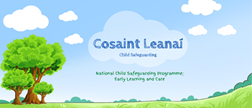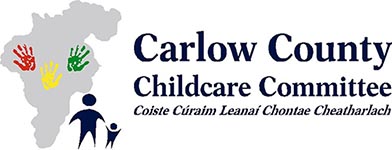Domestic Abuse Info Blast 14/01/2021
Reports in the media from Tusla and Domestic Abuse organisations are indicating a significant increase in incidents of domestic abuse during the Covid 19 pandemic. Research shows that there is a very strong link between incidences of domestic abuse and child safeguarding concerns. In light of this, it is important that we remain particularly vigilant of those in our Early Learning and Care and School Aged Childcare services who may be experiencing domestic abuse.
Domestic abuse occurs across society, regardless of age, gender, race, sexuality, wealth and geography. Domestic violence also includes sexual violence, including exposure to children and young people to visual material
Domestic Abuse is defined as:
“The use of physical or emotional force or the threat of physical force, including sexual violence in close adult relationships. It can also involve emotional abuse; the destruction of property, isolation from friends, family and other potential sources of support; threats to others including children; stalking; and control over access to money, personal items, food, transportation and the telephone.”
HSE Policy on Domestic, Sexual and Gender Based Violence
Domestic abuse includes violence perpetrated by a spouse, partner, son, daughter or any other person who has a close relationship or lives with the victim.
The term ‘domestic abuse’ goes beyond physical violence and can also involve:
- Emotional abuse
- The destruction of property
- Isolation from friends, family and other potential sources of support
- Threats to others including children
- Stalking
- Control over access to money, personal items, food, transportation and the telephone.
- Coercive control as defined in Section 39, Domestic Violence Act, 2018
Some Messages from Research in Relation to Domestic Abuse
- During the vast majority of incidents of domestic abuse, children are in the same room or the next room. The link between child physical abuse cases and domestic abuse is high, with estimates ranging from 30% to 66%.
- Studies show that adult partners who are violent towards each other are also at increased risk of abusing their own children.
- Children who live with domestic abuse are at increased risk of behavioural problems, emotional trauma and mental health difficulties in adult life.
- It is important to always consider the implications of any domestic abuse for unborn children since pregnancy and after the birth of a new baby are some of the highest risk periods for women.
There are many risks to children who live with domestic abuse. Some of these are outlined below:
- Direct physical or sexual abuse of the child or children.
- The child being abused as part of the abuse against the nonabusing parent.Being used as pawns or spies by the abusive partner in an attempt to control the non- abusive parent.
- Emotional abuse to the child from witnessing the abuse
- Physical injury to the child by being present when the violence occurs
- Hearing abusive verbal exchanges between adults in the household, including humiliation and threatened violence
- Observing bruises and injuries sustained by their parent
- Observing the abusive partner being removed and taken into Garda custody
- Witnessing their parent/carer being taken to hospital by ambulance
- Attempting to intervene in a violent assault
- Being unable or unwilling to invite friends to the house
- Frequent disruptions to social life and schooling because of moving house to flee violence or living in a refuge
- Hospitalisation of the non-abusing parent/carer.
Child Protection and Welfare Practice Handbook 2
In an Irish Context:
- 3,823 specific incidents of child abuse disclosed during contacts with direct services in 2016. These are incidents where the perpetrator was directly abusing the children of the relationship, as well as the mother.
- The kinds of abusive tactics used directly against children living in domestic abuse situations disclosed during contacts with direct services in 2016 include: o Theabusersmackingandhittingchildren(includingwithhouseholditems);
o Theabuserphysicallyandsexuallyabusingchildren
o Theabuserconstantlyshoutinginchildren’sfaces
o Childrenwitnessingverbal,physical,andsexualabuseagainsttheirmother. - There were 15,952 calls responded to by the Women’s Aid National Free Helpline in 2016, 550 of whom identified themselves as migrant women, traveller women and/or women with disabilities
- 96% of callers to the 24-hour National Freephone Helpline were women, whereas 4% of callers were men.
- Women who experience domestic abuse have, on average, experienced it 35 times before they ask for help, and then make between 5 and 12 different contacts in an effort to end the violence.
Child Protection and Welfare Practice Handbook 2
If you suspect that a child or family in your service is experiencing domestic abuse, or if you have any concerns about the welfare or protection of a child in relation to domestic abuse in the household, advice must be sought from Tusla Social Work.
In this situation, services should follow their child safeguarding policies and reporting procedures, including discussing concerns with the designated liaison person (DLP) in their service.
Further Information on Domestic Abuse can be found below:
www.tusla.ie/services/domestic-sexual-gender-based-violence/
www.womensaid.ie/services/helpline.html Phone: 1800 341 900
www2.hse.ie/wellbeing/mental-health/domestic-violence-and-abuse.html
www.garda.ie/en/crime/domestic-abuse/domestic-abuse.html
www.safeireland.ie/
Services should also, where possible, have access to contact details for local domestic abuse services and share these where appropriate.
Barnardos have many resources available through their Childhood Domestic Violence and Abuse project and have also created a video which highlights the impact of Domestic Violence and Abuse on children. These resources can be viewed here:
www.barnardos.ie/resources/childhood-domestic-violence-abuse
http://childsafeguardingelc.ie/domestic-abuse/

